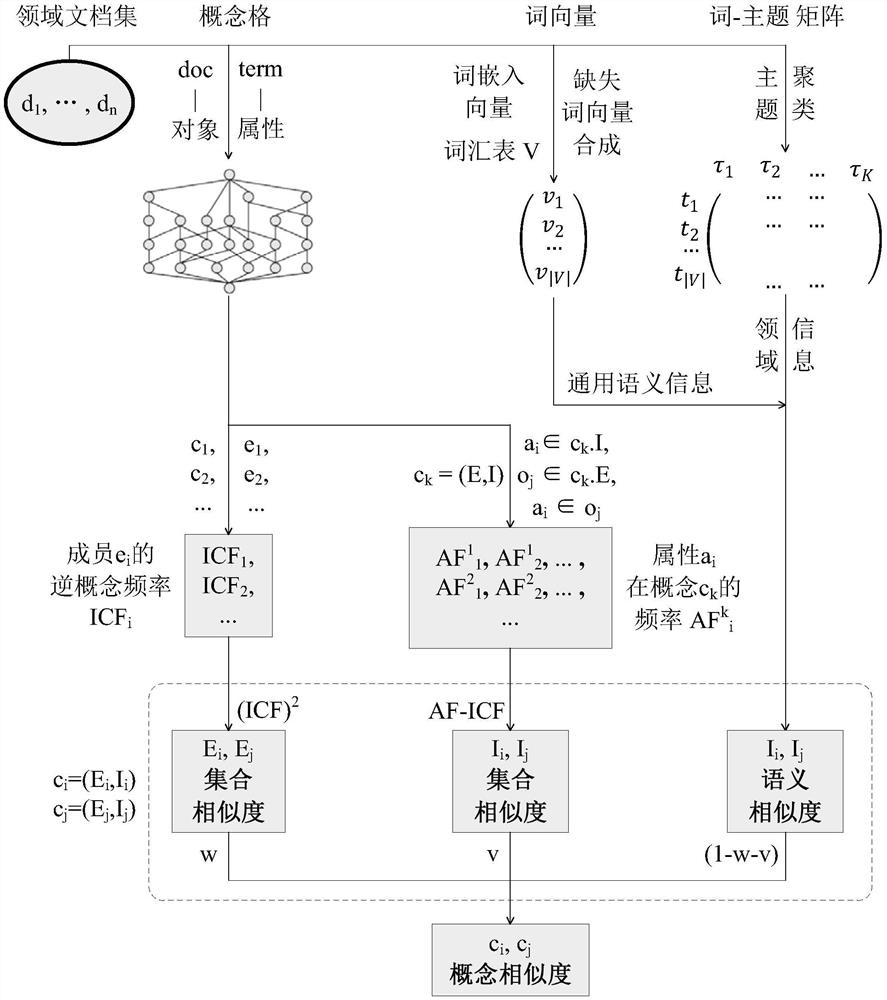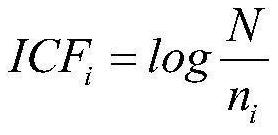Form concept similarity rapid measurement method with both general semantics and domain semantics
A general semantic and formal concept technology, applied in the field of information retrieval, can solve the problems that the semantic information of the knowledge base cannot be included, and the process of computing the connotative semantic similarity of the information in the data set field is complicated, etc., and achieve the effect of fast measurement process and remarkable effect
- Summary
- Abstract
- Description
- Claims
- Application Information
AI Technical Summary
Problems solved by technology
Method used
Image
Examples
specific Embodiment approach 1
[0024] Specific implementation mode one: combine figure 1 To describe this embodiment,
[0025] Definition of Terms
[0026] Formal background: Formal background F is a triplet, that is, F=(O,A,R); among them, O is an object set, and the element o in the object set O is called an object; A is an attribute set, and the attribute set A The element a in is called an attribute; R is a binary relation between O and A defined by the Cartesian product, namely Given two sets and but When the formal background takes documents as objects and words in the documents as attributes, such formal backgrounds are called textual formal backgrounds;
[0027] Formal concept: A formal concept C on a formal background F=(O,A,R) is a two-tuple, namely c=(E,I), where, And satisfy E'=I, I'=E, E is the extension of concept C, I is the connotation of concept C;
[0028] Concept lattice: the set of all concepts c on the formal background F and the inclusion relationship between the extension ...
specific Embodiment approach 2
[0040] In the fast measurement method for formal concept similarity with both general semantics and domain semantics described in this embodiment, in step 1, for the constructed concept lattice, the inverse concept frequency of all members and the attribute frequency of all attributes are obtained, respectively Obtain the importance of each member; the specific process includes the following steps:
[0041] Each concept in the concept lattice contains several members. If a member is contained by many concepts, the member is relatively common. Conversely, if a member is contained by only a few concepts, the concept is more specific. , two concepts share such members, the possibility of the two concepts being similar is high;
[0042] For the concept lattice L, calculate the inverse concept frequency ICF of each member:
[0043] Calculation of member e in concept lattice L i The inverse concept frequency ICF i , the formula is:
[0044]
[0045] Among them, N is the total n...
specific Embodiment approach 3
[0055] In the fast measurement method of formal concept similarity with both general semantics and domain semantics described in this embodiment, the cosine similarity of the two intensional vectors is calculated using the number of times words existing in the two intensions belong to the same topic class in step two The specific process of making corrections and obtaining the semantic similarity of the two connotations including general semantics and domain semantics includes the following steps:
[0056] For two concepts of the form c 1 =(E 1 , I 1 ) and c 2 =(E 2 , I 2 ), E 1 , I 1 concept c 1 The extension and connotation of E 2 , I 2 concept c 2 The extension and connotation of the two connotations can be expressed as: I 1 ={t 1 ,t 2 ,...,t a ,t x1 ,t x2 ,...,t xb} and I 2 ={t 1 ,t 2 ,...,t a ,t y1 ,t y2 ,...,t yb}, I 1 and I 2 The elements in are the contained words, obviously, I 1 and I 2 Contains a (a≥0) identical words, and when a=0, the tw...
PUM
 Login to View More
Login to View More Abstract
Description
Claims
Application Information
 Login to View More
Login to View More - Generate Ideas
- Intellectual Property
- Life Sciences
- Materials
- Tech Scout
- Unparalleled Data Quality
- Higher Quality Content
- 60% Fewer Hallucinations
Browse by: Latest US Patents, China's latest patents, Technical Efficacy Thesaurus, Application Domain, Technology Topic, Popular Technical Reports.
© 2025 PatSnap. All rights reserved.Legal|Privacy policy|Modern Slavery Act Transparency Statement|Sitemap|About US| Contact US: help@patsnap.com



